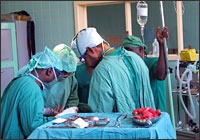Ten facts on safe surgery
"Surgical care and its safe delivery affect the lives of millions of people. About 234 million major operations are performed worldwide every year", according to the World Health Organization (WHO). To avoid - possibly fatal - complications the WHO introduced a checklist on safe surgery.

WHO introduces surgery checklist for patients safety.
Surgery is safe. But not always. Studies indicate that complications following surgery result in disability or prolonged stay in 3-25% of hospitalized patients depending on the complexity of surgery and the hospital setting. This would mean that at least 7 million patients annually may suffer from post-operative complications. "Using the checklist is the best way to reduce surgical errors and improve patient safety", said Dr Margaret Chan, Director-General of WHO.
Several studies have shown that in industrial countries major complications occur in 3% to 16% of inpatient surgical procedures, and permanent disability or death rates are about 0.4% to 0.8%. In developing countries, studies suggest death rates of 5% to 10 % during major operations. Mortality from general anaesthesia alone is reported to be as high as one in 150 in parts of sub-Saharan Africa. Infections and other postoperative complications are also a serious concern around the world. These studies suggest that about half of these complications may be preventable.
"Surgical care has been an essential component of health systems worldwide for more than a century," said Dr Atul Gawande, a surgeon and professor at the Harvard School of Public Health. "Although there have been major improvements over the last few decades, the quality and safety of surgical care has been dismayingly variable in every part of the world. The Safe Surgery Saves Lives initiative aims to change this by raising the standards that patients anywhere can expect."
The Safe Surgery Saves Lives initiative is a collaborative effort led by the Harvard School of Public Health. More than 200 national and international medical societies and ministries of health are working together to reduce avoidable deaths and complications in surgical care. The WHO surgical safety checklist, developed under the leadership of Dr Gawande, identifies a set of surgical safety standards that can be applied in all countries and health settings.
Preliminary results from a thousand patients in eight pilot sites worldwide indicate that the checklist has nearly doubled the likelihood that patients will receive proven standards of surgical care. Use of the checklist in pilot sites has increased the rate of adherence to these standards from 36% to 68% and in some hospitals to almost 100%. This has resulted in substantial reductions in complications and deaths in the 1000 patients. Final results on the impact of the checklist are expected in the next few months.
The checklist identifies three phases of an operation, each corresponding to a specific period in the normal flow of work: before the induction of anaesthesia ("sign in"), before the incision of the skin ("time out") and before the patient leaves the operating room ("sign out"). In each phase, a checklist coordinator must confirm that the surgery team has completed the listed tasks before it proceeds with the operation.
For example, during the "sign in" phase, the coordinator should check whether the surgical site on the patient's body was properly marked and whether the patient's known allergies were checked. During the "sign out" phase, instruments, sponges and needles should be counted to check that none of these is accidentally left behind in the patient's body. The checklist released today will be finalized for dissemination by the end of 2008 once the evaluation of the eight pilot studies is complete.
Photo: WHO
01.07.2008
More on the subject:









